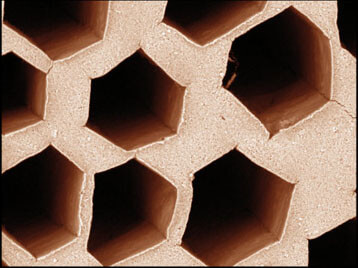The discovery provides many advantages, including low production costs, stability and easy use of the compound, advantages that will pave the way for industrial applications.

A chemical compound used to stabilize particles in suspension has been shown to control the growth of ice crystals. Surprisingly, the compound in question is a simple molecule and is completely different from macromolecules known today as anti-freezing agents. The discovery provides many advantages, including low production costs, stability and easy use of the compound, advantages that will pave the way for industrial applications.
The research findings, published in the scientific journal PLoS ONE, also provide new clues for the development of synthetic mimics of anti-freeze proteins, different from those currently on the market.
The formation of ice crystals can cause many damages, sometimes even devastating, such as the disintegration of the cell in living organisms, damage to the ground and roads in icy weather conditions, the formation of ice crystals in ice creams and more. All these are examples of situations in which controlling the formation of ice is beneficial and useful. Many organisms and creatures living in cold environments have adapted throughout history and are able to control the formation of ice. Their survival at low temperatures depends on the presence of antifreeze proteins, all of which consist of very long organic chains with an amphiphilic structure [amphiphilic, consisting of both water-soluble (hydrophilic) and water-insoluble (hydrophobic)] groups. How do these proteins react with ice crystals? Researchers are trying to identify and explain the mechanism that allows anti-freezing proteins to recognize these crystals, but the phenomenon is still not fully understood. In addition, since the cost of producing these proteins is particularly high, the preferred solution is to prepare synthetic imitations inspired from natural structures. All the proteins known today for their anti-coagulation properties are macromolecules (such as glycoproteins, polysaccharides, etc.).
French researchers from the CNRS research institute discovered that zirconium acetate, a chemical compound that is normally used to stabilize particles in suspension, is able to control the formation of ice crystals. The compound dictates the structure of the ice crystals obtained during the freezing of a solution containing water. The crystals obtained following the addition of zirconium acetate are very uniform, while those obtained without it are amorphous.
These findings are quite surprising, this is in light of the fact that zirconium acetate is a salt - a simple compound that is radically different from the macromolecules known for their anti-freezing properties. Until now, this compound was not known as a substance capable of controlling the formation of ice crystals. This control can be performed in several ways: by reducing the growth speed of the crystals (in order to reduce their formation), by reducing the freezing point (in order to delay their formation), or by controlling their structure, as occurs in this case. Because this finding suggests a direct reaction with the ice crystals, the researchers were surprised to find that molecules as diverse as zirconium acetate and proteins are able to influence crystal formation.
This compound provides significant advantages compared to existing equivalents, whether natural or synthetic. The compound is cheap to produce, stable, "simple", and easy to use, characteristics that bode well for future industrial applications. In addition, since this compound is completely different from all substances previously identified and/or developed for this use, further research may lead to the development of other molecules with anti-coagulation properties. This research was made possible thanks to the use of advanced X-ray diffraction techniques and imaging methods.

One response
Where do you buy one? I'm freezing cold here